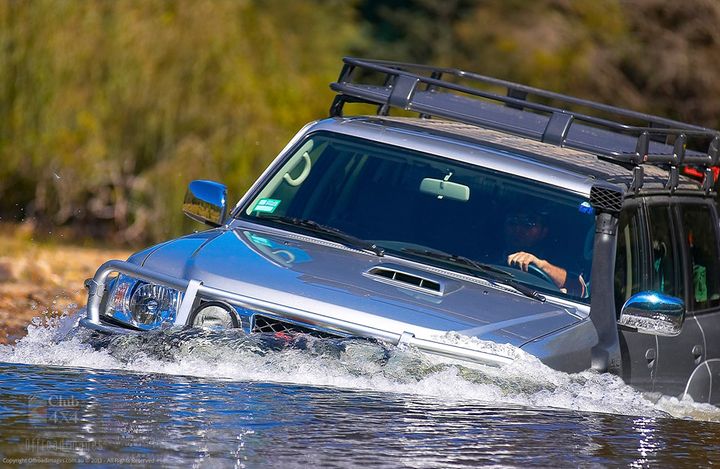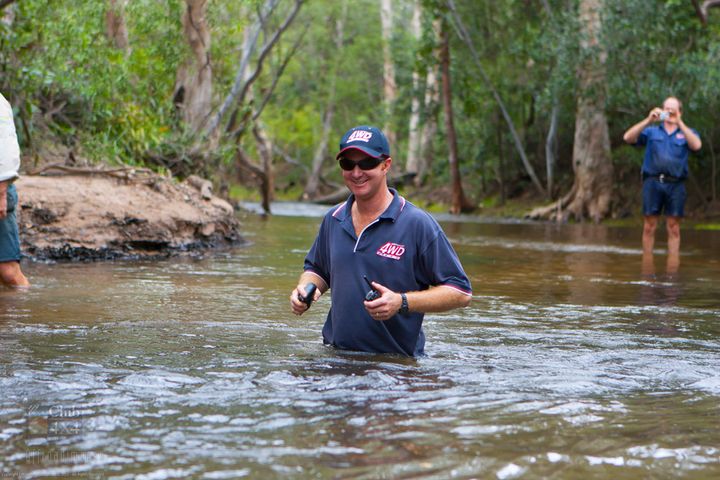Water Crossings: What You Need to Know
With so many great products available for 4WDs, we have greater opportunities to see Australia confidently and safely than ever before as our vehicles are more capable. Having the right gear to suit your adventure …

With so many great products available for 4WDs, we have greater opportunities to see Australia confidently and safely than ever before as our vehicles are more capable.
Having the right gear to suit your adventure will always make things easier and more enjoyable.
Understanding the importance of the right gear requires much research by the vehicle owner, but experience will always grow your ideas to ensure that this amazing gear is utilised properly.

I met a young guy this week with a great looking 75 Series Landcruiser Troop Carrier who was asking for some advice about travelling a long trip to the High Country and then through to South Australia.
It was great to see his enthusiasm for this recently purchased second hand 4X4 and I recognized he was going to be enjoying this pastime for many years to come.
It got me thinking and searching for recommendations of where he should go for a quick visit to the High Country that would provide a taste of what this beautiful area of Australia offers him for the future.
But before these recommendations would be provided, I needed to think carefully as to what this trip should cover. How will this second hand 4WD handle travelling the High Country and then drive another 8,000 kms considering he doesn’t really know its history. Now it would have been great if he had time to arrange for a pre-trip inspection, but that’s not happening this side of his trip.

I put together an article about the importance of a pre-trip inspection which is worth a read…
The Importance of a Pre-Trip Inspection
It was clear to me that this vehicle is in the right hands of an enthusiast who will look after it extremely well, but would it be ready for some of the locations in the High Country?
I figured out a route which would keep him away from river crossings but still sample good 4WDing, including some great High Country Huts and take in stunning views and campsites.
When their 75 Series Cruiser is ready for a bigger journey, they can head back there and explore further.

Why did I suggest staying away from the river crossings? There is one sure thing to ruin a holiday experience, and that is going unprepared into a water crossing and creating a vehicle failure later in that trip. Maybe by the time he hits the Flinders Ranges, a problem with a failed bearing could raise its ugly head, just because of a single water crossing. As well as having the potential of destroying a holiday, this would have a negative effect on the couple’s experience for certain.
Let’s talk about what a water crossing could create as a problem for us.
If you are heading on a trip these holidays and are planning on getting out there in areas like the High Country, can I make a couple of suggestions?
Are you prepared for water crossings and the negative effects they can have on your 4WD?
Firstly, are you familiar with the rivers in the High Country? It needs to be understood that with the rain that we have had recently, these river crossings may have changed. Not only are the rivers potentially higher than you have seen, but the crossings may be a little different to the last time you were there.
Are you properly prepared?

Relating to Water Crossings, the most common upgrade for a 4X4 would be the snorkel. It goes without saying that a snorkel will assist anyone to tackle those river crossings providing a safe wading depth for your vehicle to get to the other side. It provides a lot more confidence to the driver as the engine takes clean air well above the water level. But there are good and bad snorkels on the market, some of which should not be considered as snorkels at all… more “raised intakes” and be sure to know, I’ll be writing a story about snorkels in the coming weeks.
But there are so many things that can go wrong, even with a snorkel.
Rivers are difficult to read and whilst a clear stream can look picturesque and inviting, the actual depth can be hard to gauge. Even for the experienced 4WDer, a clear stream can sometimes surprise you as it’ll usually be deeper than it looks. Walking the crossing is the best way to discover so many aspects of a river. How slippery is the bottom or does it consist of soft sand? Are there any obstacles or deep holes to avoid? How fast is the river current? Will it be safe to cross? Walking the river crossing really is the best way to find out for yourself rather than driving in without any knowledge. Of course, care must be taken to avoid losing your footing and ending up downstream.

We talked about the obvious importance of a snorkel for your engine, but have you heard of extended diff breathers? These are so important for a well set-up 4WD. Diff breathers are basically snorkels for your diffs, and maybe your transfer case and gearbox. They allow for the expansion and contraction of air in these important components as they heat up or cool down. So, if you have been driving down a hill like in the high country and your mechanical components are getting hot, when you enter a water source of any kind, be it muddy or clean water, the hot metals will be rapidly cooled sucking in air through the diff breather. Without extended diff breathers, it is highly likely that the quenching of these mechanicals can draw water through seals and into cavities where there should only be oil or grease. Now you might not realise you have created a problem now, but sometime down the track either on this trip or maybe your next, things will heat up and problems will rise to the surface. Most 4WDs have diff breathers which might be as simple as a venting cap, or a short breather line located a little higher than the diff itself, but the idea here is to bring the hose from the diff to a location which water won’t get to during a water crossing. If you are going to be regularly heading off road, you really should add diff breathers to your vehicle.

If you don’t have extended diff breathers, there are a couple of things you can do to minimise this potential problem.
Places like the High Country have tracks which take you high into the hills and then back down into the valleys where you might have a river crossing or two to navigate before you again climb to the next hill. With this, your 4WD engine and transmission might be working quite hard to climb and your brakes might also get a workout as you descend. By the time you arrive at a water crossing, everything will be extremely hot. It would be a really good idea NOT to travel through the water crossing with your 4WD heated up like this.

How can you prevent this heat build-up?
1. Reduce heavy braking. Heavy braking will heat up the disc brakes and this heat will transfer into the axles, bearing, and seals. Use low range when descending steep terrain avoiding the use of heavy braking or maybe removing the need for braking at all.
2. Transmissions heat up on steep terrain. If you are running an automatic transmission, or even for the manual gearboxes, us low range during steep climbs to reduce over-heating of the gearbox which will certainly get a quenching in a water crossing.

3. Take a moment to take it all in. When you arrive at a deep-water crossing, pull up somewhere safe and enjoy the location. Take a few photos and have a look around. Enjoy this stunning spot. You might want to walk the crossing and plan everything. If something goes wrong, are you prepared. Where is the recovery gear and recovery points? Why not attach it before you get into trouble. If you were using low range and engine braking, its more than likely that by the time you have entered the water, your most critical mechanical components will be fine for the drenching. If you ever see water steaming off brakes and mechanical components, you will understand what I am talking about. This should not be happening.

I put together an article about tips on using recovery gear which is worth a read…
Have you ever thought about your door seals? Before entering a deep-water crossing, go to the trouble of wiping all the door rubbers on your vehicle with a damp cloth removing dust from them and also the painted surfaces on the pillars and sills to ensure a strong seal against the pressure of the water. You will be surprised at how much of a difference this will make. If your progress is reduced through loss of traction, you will be less likely for the water to enter the vehicle.

The wrong tyre pressures could result in a loss of traction. If you were to approach a hill climb of loose gravel or a beach entry with soft sand, you would let your tyres down to suit the terrain. With a water crossing it’s difficult to see what traction is offered on the crossings base, so you’ll have no idea what pressure you should run. If you haven’t reduced your tyres down, it might be a good idea to do so now to provide better traction and assist you in a successful crossing. I have never seen anyone letting their tyres down whilst stuck in the middle of a river, but you see it all the time in soft sand on the beach.

Don’t smash through the water crossing as you could cause all sorts of damage. With your electric windows open, proceed into the water crossing whilst trying to keep forward progress to create a bow wave in front of your vehicle. This will ensure an air pocket in the engine bay and will also push water away from the middle of the vehicle to some degree. Aftermarket Water Crossing blankets or blinds are available to assist you with this or you could use a tarp strapped over the front of the vehicle. Just make sure that it is fixed extremely well to ensure it doesn’t become entangled in your running gear.

Most importantly, go prepared for the adventure that you want to be part of, and you and your passengers will enjoy it so much more.
“Cheers”
-Michael Ellem
Offroad Images

The Campfire – Feedback
Just like sitting around the campfire, we would love to hear what you have to say. You can be involved simply by entering your comments below.
Also… we will be featuring stories about photography tips and tricks, 4X4 preparation, build planning and maintenance, as well as featuring inspirational locations for you to visit in your 4X4. So please get involved and let us know what you’d like to hear about. If you have any requests for stories to be featured in campfire or would like to provide feedback about this article, please send us a message on our social links:
Instagram: @offroadimages
Facebook: @offroadimages
YouTube: youtube.com/OffroadImages
Website: www.offroadimages.com.au
As 4X4 enthusiasts who live for the opportunity to create awesome imagery anywhere in Australia, we know that our vehicle assets are covered wherever we travel to create that shot, as we are insured by Club 4X4.

